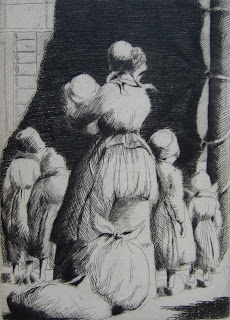Else Ruest, Landschaft
Etching with aquatint, 1898
Else (Elisabeth) Ruest was born in Hanover in 1861, and studied under V. Roman, Richard Volkmann and Herman Gattiker. She died in 1945. There are a number of paintings by her in the Hanover Museum, but like so many women artists she seems to have been largely forgotten. This is the only etching of hers that I have seen.
Peter Halm, Landschaft
Etching, 1898
Peter Halm was born in Mainz in 1854. From 1895 Peter Halm was professor of etching at the Munich Kunstakademie, where he himself studied under Raab and Lofliz. He died in 1923.
Felix Hollenberg, Landschaft
Etching, 1898
Felix Hollenberg was born in Sterkrade in 1868. He studied at the Academies of Düsseldorf and Stuttgart, where his professor was Albert Kappis. He won a bronze medal at the Exposition Universelle in Paris in 1900. The Felix Hollenberg Galerie, dedicated to his art, is in Gomadingen, Germany, where he died in 1945.
Walter Leistikow, Landschaft
Etching, 1898
Walter Leistikow was born in Bromberg (the German name for Bydgoszcz in Northern Poland) in 1865. Leistikow studied in Berlin in the atelier of the Norwegian painter Hans Frederik Gude. He was also strongly influenced by the poet Gerhart Hauptmann. Walter Leistikow was one of the artist who developed the language of Symbolism into the Jugendstil (German Art Nouveau) movement; see this article at The Textile Blog for his wallpaper designs. In the latter half of the 1890s he contributed original etchings to the revolutionary art journal Pan. This marked his break from the conventional art establishment of the day, with which Leistikow had been associated as a Professor at the Berlin Academy of Fine Art from 1890-1893. By 1898 his landscape art, of which this is I think a very fine example, had developed into full-blown Expressionism. It was so threatening to the German art establishment that in that year Leistikow's work was rejected by the Berlin Academy as below standard. Walter Leistikow's increasing estrangement from the official art of the day was marked in 1899 by his role as one of the founders of the Berlin Secession. He died in 1908 at the age of just 42.




































